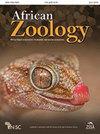Interspecific Competition for Cliff Ledges on the Magaliesberg between Nesting Verreaux's Eagles and Roosting Chacma Baboons
IF 0.5
4区 生物学
Q4 ZOOLOGY
引用次数: 0
Abstract
Animals that share suitable rock ledges located on near-vertical cliff faces are compelled to interact when using this scarce resource. Because interspecific and exploitative competition for suitable ledges may have a vital influence on the survival and reproduction of Verreaux's Eagles (Aquila verreauxii) and Chacma baboons (Papio ursinus), an investigation into the reciprocal rock-ledge usages by the two species will improve our understanding of this trait. In this study, we used camera traps stationed at four eagle nests to study interspecific interactions at nest sites. At the first two eagle nests, no baboons were recorded, and two young birds fledged successfully. At the third nest, the baboons only slept on the nest once the fledgling successfully left the nest. At the fourth nest, the eagles did not breed and the birds (eight visits) and baboons (three visits) used the nest interchangeably over a 28-day period. Whereas the cliff-ledge provided a secure nest site for the Verreaux's Eagles in the breeding season, for Chacma baboons sleeping on an inaccessible ledge may limit predation by terrestrial predators (e.g. by leopard Panthera pardus). This alternating usage of cliff ledges suggests that the two species probably co-use this limited cliffside resource to increase their own fitness.筑巢的Verreaux鹰和雄鸡Chacma狒狒在Magaliesberg悬崖上的种间竞争
在使用这种稀缺资源时,共享位于接近垂直悬崖表面的合适岩石壁架的动物被迫互动。由于对合适岩架的种间和剥削性竞争可能对Verreaux鹰(Aquila verreaxii)和Chacma狒狒(Papio ursinus)的生存和繁殖产生重要影响,对这两个物种相互使用岩架的调查将提高我们对这一特征的理解。在这项研究中,我们使用驻扎在四个鹰巢的相机陷阱来研究巢址的种间相互作用。在最初的两只鹰巢中,没有记录到狒狒,两只幼鸟成功地长出了翅膀。在第三个巢穴,只有当刚出笼的狒狒成功离开巢穴时,它们才会睡在巢穴上。在第四个巢穴,鹰没有繁殖,鸟类(八次造访)和狒狒(三次造访)在28天的时间里交替使用巢穴。悬崖边在繁殖季节为Verreaux’s Eagles提供了一个安全的巢穴,而睡在人迹罕至的悬崖边上的Chacma狒狒可能会限制陆地捕食者(如豹豹)的捕食。这种对悬崖壁架的交替使用表明,这两个物种可能共同使用这种有限的悬崖边资源来增加它们自身的健康状况。
本文章由计算机程序翻译,如有差异,请以英文原文为准。
求助全文
约1分钟内获得全文
求助全文
来源期刊

African Zoology
生物-动物学
CiteScore
2.60
自引率
9.10%
发文量
18
审稿时长
>12 weeks
期刊介绍:
African Zoology , a peer-reviewed research journal, publishes original scientific contributions and critical reviews that focus principally on African fauna in terrestrial, freshwater, and marine ecosystems. Research from other regions that advances practical and theoretical aspects of zoology will be considered. Rigorous question-driven research in all aspects of zoology will take precedence over descriptive research. The Journal publishes full-length papers, critical reviews, short communications, letters to the editors as well as book reviews. Contributions based on purely observational, descriptive or anecdotal data will not be considered.
The Journal is produced by NISC in association with the Zoological Society of South Africa (ZSSA). Acceptance of papers is the responsibility of the Editors-in-Chief in consultation with the Editors and members of the Editorial Advisory Board. All views expressed are those of the author and not necessarily those of the Editors or the Department.
 求助内容:
求助内容: 应助结果提醒方式:
应助结果提醒方式:


